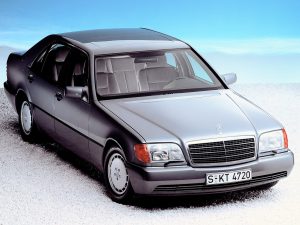Recalls: Mercedes-Benz W140/V140 S-Class
Overview
Manufacturers, or importers, issue recalls for defects or faults which have the potential to cause injury. Generally, manufacturers will inform the original buyers if their vehicle is subject to a recall and of the steps required to remedy the defect or fault. Please note that the recalls below (if any) are for Australian-delivered vehicles only. Furthermore, the number of recalls should not be taken as an indication of a model’s reliability or its safety more generally.
Recalls: Mercedes-Benz W140/V140 S-Class
- In July 1996, a recall was issued for Mercedes-Benz W140/V140 S-Class models fitted with V8 engine and manufactured between January 1991 and December 1994. In these vehicles, a leak may occur in the vacuum hose between the engine manifold and the brake booster – this could result in brake failure (PRA 1996/2859).
- In March 1997, a recall was issued for Mercedes-Benz W140/V140 S-Class vehicles due to the front flexible brake hoses potentially rubbing on the inside of the tyre when the wheels were turned to full lock – this could result in a loss of brake fluid and brake effectiveness (PRA 1997/3104).
- In November 1999, a recall was issued for Mercedes-Benz W140/V140 S-Class vehicles that were manufactured between June 1995 and November 1996. In these vehicles, moisture may cause corrosion in the driver’s airbag mechanism and cause it to deploy (PRA 1999/4170).
Problems and faults: Mercedes-Benz W140/V140 S-Class
Overview
This section identifies potential problems, causes and fixes based on the experiences of owners and repairers, online sources and technical service bulletins. This information is provided solely for reference purposes and AustralianCar.Reviews recommends that only properly qualified persons carry out repairs or modifications. Furthermore, the number of items below should not be taken as an indicator of a model’s reliability or the frequency with which they may occur.
To report a problem or fault to the AustralianCar.Reviews team, please use the Contact Us form. Note that AustralianCar.Reviews does not offer advice on automotive problems or disputes; such enquiries will not receive a reply. For vehicles purchased from dealers after 1 January 2011, please see our Australian Consumer Law fact sheet.
Problems and faults: Mercedes-Benz W140/V140 S-Class
- For a vehicle as complex as the W140 S-Class, a pre-purchase inspection by a Mercedes-Benz mechanic is highly recommended.
- For pre-1996 models, the fuel injection harness (or engine harness) is susceptible to failure. The pre-1996 harnesses had biodegradable insulation which could degrade and cause a short circuit. Symptoms of a failed fuel injection harness include a temporary loss of power when accelerating from rest, rough idling, stalling and a failure to start. At worst, a failed harness can cause damage to the fuel injection system. An improved harness was introduced in 1996.
- For pre-1996 models, the air conditioning evaporator could leak due to corrosion of the evaporator connections (chemical reaction between different metals). Replacing the evaporator requires the entire dashboard to be removed, making this is a time-consuming and expensive repair.
- The computer-controlled PSE (Pneumatic System Equipment) pump is responsible for the locks, lumbar support, rear parking guides, boot lid release and vacuum to the HVAC servos (for the REST feature). Potential problems include vacuum leaks, leaking vacuum connections or hoses and a failed pump motor. Symptoms of problems with the vacuum pump include faulty door locks, front seat lumbar adjustment, rear parking guides and boot lid release.
- Furthermore, the S-Class has a separate pump for the self-closing (or soft-closing) doors and boot lid which can experience similar problems to the PSE pump.
- The five-speed automatic transmissions did not have a recommended oil change interval and this lack of servicing may result in failure. For this reason, transmission oil changes are recommended every 60,000 kilometres.
- Due to the weight of the vehicle, suspension components – such as the bushes in the suspension sub-frames – will likely require replacement after 200,000 km.
- The front coil springs can break at the base of the coil, while rear springs can also break at the top of the coil. Broken springs will result in poor bump absorption. Note that specialist tools are required to remove the front springs.
- Power window motors fail with age – in part, this is due to the heavy double glazed windows.




